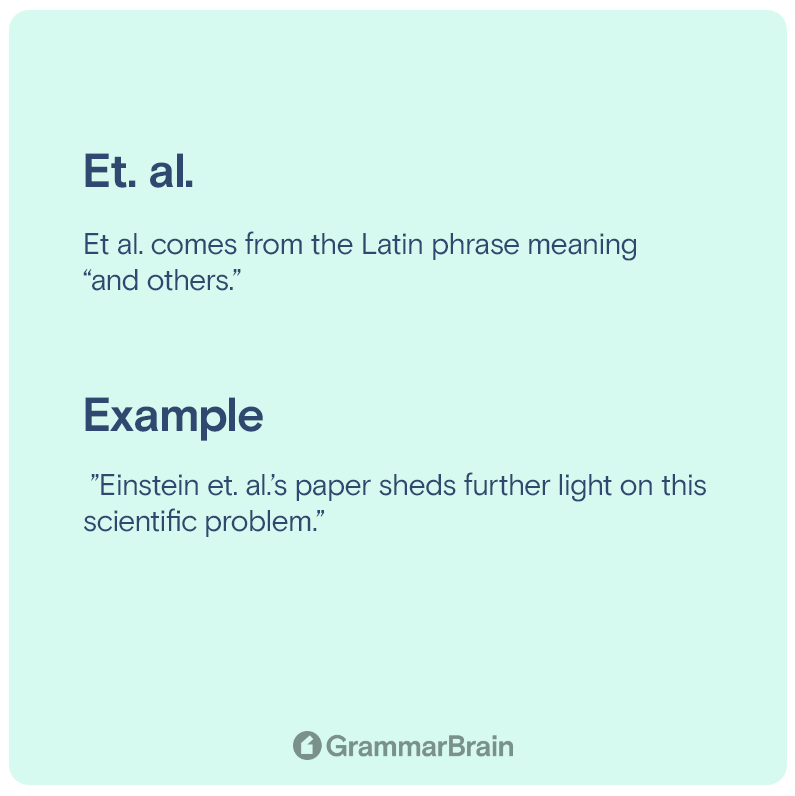What does “et. al.” mean? Et. al., e.g., and i.e., these are all very confusing abbreviations in the English language. When are they used? And how are they used? Do they have commas before or after them? Using these abbreviations can make a dramatic impact on formal writing tones. And help with supportive statements.
Learn the differences between these forms in this grammar guide…
What Does “Et Al.” Mean?
Et al. is the abbreviated version of the Latin phrase “et alia” which translates to “and others” in English.
This phrase is mainly found in formal writing and documentation to cite the authors and editors of a particular piece of work.
For example, someone might use “et al” to continue the train of thinking for the reader. Here’s an example, “The book was published by multiple sources. Penguin, Source Books, et. al.” Although, more commonly, it is used for in-text citations. Continue reading to learn more.
| Form | Definition |
| Et. Al. | Et al. comes from the Latin phrase meaning “and others.” |
How to Use “Et Al.”
You can use the word “et al.” to improve the readability of formal writing by reducing the number of people or sources you cite.
Listing too many sources reduces overall readability and interrupts the flow of ideas. It’s not uncommon to encounter peer-reviewed articles with upwards of 20 cited sources and authors.
Listing every single person involved in the project makes it difficult for readers to locate the text they are looking for.

Use this abbreviation areas like the following:
- Footnotes and endnotes
- Bibliography
- Reference lists
- Parenthetical citations
- Narrative citations
The rules of use can vary according to style guides (note the table listed at the bottom of this article). As a general rule, is to use et al. when work has three or more people to cite.
To use it, simply write the name of the first author, and replacing subsequent names with the phrase “et al.” Only include the first author’s last name, followed by “et al”, a comma, and list the year of the work’s publication.
To know how et al. Is used in legal documents, refer to this page.

Examples
When you encounter a citation that reads “Schouten, McAlexander, Bippy, Koenig 2010”, you can rewrite it as “Schouten et al., 2010.”
If you encounter the citation “Snad, Aarons, Witberg & Biggens 2000,” you canwrite it as “Snad et al., 2000.”
If you want to know how different style manuals use et al., read this page. Or continue reading to see the reference tables below.
| i.e. | e.g. | etc. |
| id-est | exempli gratia | et cetera |
| “That is” or “in other words” | “For example” | “And others” or “And so on” |
How to Misuse “Et Al.” (Incorrect Use)
First, “et al.” must always get written as two words, with the “al” followed by a period. The period is what indicates to readers that it is an abbreviated word.
Do not use “et al.” as a stand-in for the third author in a citation. ”Et al.” cannot get pluralized.
Another common mistake is when people want to indicate the possession of a paper.
The correct usage requires an apostrophe and a period in the right place. You would rewrite the above to say:
“Einstein et al.’s paper shed further light on this scientific problem” instead.

Et Al. vs. Etc. – What’s the Difference?
“Et al.” is used to indicate that there are additional authors for a particular piece of work, but they have not been listed. It should only get used when referencing people.
“Etc.” stands for “et cetera” and is translated to “and other similar things.”
Use “etc.” when listing objects, ideas, and other kinds of phenomena.
Et al. is for people. Etc. is for everything else.
Formal papers (like college and university-level essays) require proper citations (bibliographies) to provide quantitative insights to support the argument in the essay.
Usually, there’s a dichotomy of the stored papers where the bibliography and citations can assist, too. Like on stored databases that require the text and citations to be correct. For example, Research Gate is a database like this.

Examples of using “et al.” correctly
Examples of et al.
- “It might result from stardust in the ozone (Zoidberg et al., 2020).“
- “Leipzsberg et al. (2020) argue the dangers of this particular chemical.”
- ”Helmsworth et al. (2015) published some questionable conclusions.”
Examples of etc.
- “Children should eat plenty of fruits like berries, melons, etc.“
- “Please bring all the required documents such as your passport, birth certificate, etc.“
- “You can become a doctor, an engineer, etc.”
If you would like more examples of etc. used in a sentence, please read this page.
What is Et Alibi?
“Et alibi“ is a Latin phrase that literally translates to “and elsewhere.”
It is also expressed with the abbreviation “et al.”
However, the context which it gets used will reveal whether the writer is referring to et alia or et alibi.
This phrase is mainly found in academic writing (university-level research papers). It gets used to show that there are other occurrences of the information getting cited in a specific text.

Examples of “et al” in sentences
- “In her comprehensive guide on chakra pathways, the author refers to meridians on pages 22, 55, 105, et al.”
- “The author refers to the Monarch butterfly on pages 2, 14, 52, 88, et al.”
| Source | Recommendation |
| Chicago Manual of Style | Comma is used after i.e. and e.g. |
| Blue Book of Grammar and Punctuation | Commas are preferable/optional only after abbreviations. |
| The Columbia Guide to Standard American English | [Editors] require a comma after the second period [in these abbreviations]. |
| The Guide to Grammar and Writing | The comma [following i.e. and e.g.] |
| Lynch Guide to Grammar | Both abbreviations should get followed by a comma. |
| Fowler’s Modern English Usage | Commas don’t typically follow i.e. (No comment on e.g.) |
Understanding MLA style in-text citations and “et. al.”
Here’s how to understand MLA Style and “et. al.”
| Number of authors | In-text citation | Works Cited entry |
| 1 author | (Anderson 37) | Anderson, Smith. |
| 2 authors | (Anderson and Brian 37) | Anderson, Smith., and Brian Jay |
| 3+ authors | (Anderson et al. 37) | Anderson, Smith., et al. |
Understanding Chicago style in-text citations and “et. al.”
Here’s how to understand Chicago Style and “et. al.”
| Authors | Full note | Short note | Full note |
| 2 authors | Brian Jay and Brian Smith | Jay and Smith | Jay and Smith. |
| 3 authors | Brian Jay, Brian Smith, and Anna Jones | Jay, Smith, and Jones | Jay, Smith, and Jones |
| 4+ authors | Brian Jay et al. | Jay et al. | Jay, Smith, Jones, and Black |
Understanding APA style in-text citations and “et. al.”
Here’s how to understand APA Style (7th Edition) and “et. al.”
| Number of authors | In-text citation |
| 1–2 authors | (Smith & Johnson, 2022) |
| 3+ authors | (Cromwell et al., 2022) |
How to Remember When to Use “Et al.” vs. “Etc.” or “E.G.”
Et al. is commonly used among lawyers, theologists, doctors, and academics.
Etc. and E.G., however, are commonly used in informal communication.
A simple way to remember where you should use an abbreviation is to memorize the complete form of the word.
Etc. is only ever used to say “and other things” and only refers to specific objects in formal contexts.
In informal writing tones, you will find people mainly using “etc.” And using it when they know there are other objects they want to use as examples but can’t remember at the moment of writing.

Etc. can get used in the middle of sentences. Contrary to public misconception it can get used in the middle and end of sentences to denote a list of other items.
However, the word “etc.” already contains the word “and.” Never write something like “and etc.” Because this translates into “and and others.”
E.G. is the Latin phrase for “exempli gratia” and literally translates into “for example.”
This should get used in sentences to make the topic you’re discussing clearer to the reader.
| Form | When to use it |
| I.e. | I.e. stands for the Latin id est, or ‘that is,’ and is used to introduce a word or phrase that restates what has been said previously. |
| E.g. | Use as ‘for example,’ coming before an item or list of items. Set an immediate timeline, e.g., three weeks, to learn all this. |
| Et. al. | For sources with one, two, or three authors, list all author names in your in-text citations (whether footnotes or author-date). |
| Etc. | Use “etc.” when listing objects, ideas, and other kinds of phenomena. |
Here’s an example:
- “We have regular meetings to discuss where our company is headed (E.G., Recent successes, turnover, product strategy).”
Et al. should get used when you want your readers to be able to look up the relevant information in greater detail.
This helps to build the credibility of an idea. It should also be used when you want to properly credit and appreciate a particular piece of work by giving it due credit.

Examples of differences
- ”Moore et al., (2011) have been instrumental in the discoveries of machine learning and artificial intelligence.”
- “I would like to buy an emergency first aid kit, bandages, gloves, etc.”
- “We should prepare antidotes for the most common venomous animals that people encounter (E.G., Snakes, spiders, and frogs).”
Common questions
Questions from English writers.
When should I use “et al.” in citations?
“Et al.” (Latin for “and others”) gets used to shorten citations of sources with multiple authors.
“Et al.” is used in APA in-text citations of sources with 3+ authors, e.g. (Anderson et al., 2022). It should get used in APA reference entries.
Use “et al.” for 3+ authors in MLA in-text citations and Works Cited entries.
Use “et al.” for 4+ authors in a Chicago in-text citation, and for 10+ authors in a Chicago bibliography entry.
When should I use “et al.” in APA text citations?
E”t al.” (meaning “and others”) is used to shorten APA in-text citations with three or more authors.
Only include the first author’s last name, followed by “et al.”, a comma and the year of publication, for example (Anderson et al., 2022).
Sources:
- Etc
- Et Al. | Meaning & Use in APA, MLA & Chicago
- What Does Et Al. Mean on Real Estate Property Deeds?
- Et Al. Meaning and How to Use It
Inside this article
Fact checked:
Content is rigorously reviewed by a team of qualified and experienced fact checkers. Fact checkers review articles for factual accuracy, relevance, and timeliness. Learn more.
Core lessons
Glossary
- Abstract Noun
- Accusative Case
- Anecdote
- Antonym
- Active Sentence
- Adverb
- Adjective
- Allegory
- Alliteration
- Adjective Clause
- Adjective Phrase
- Ampersand
- Anastrophe
- Adverbial Clause
- Appositive Phrase
- Clause
- Compound Adjective
- Complex Sentence
- Compound Words
- Compound Predicate
- Common Noun
- Comparative Adjective
- Comparative and Superlative
- Compound Noun
- Compound Subject
- Compound Sentence
- Copular Verb
- Collective Noun
- Colloquialism
- Conciseness
- Consonance
- Conditional
- Concrete Noun
- Conjunction
- Conjugation
- Conditional Sentence
- Comma Splice
- Correlative Conjunction
- Coordinating Conjunction
- Coordinate Adjective
- Cumulative Adjective
- Dative Case
- Determiner
- Declarative Sentence
- Declarative Statement
- Direct Object Pronoun
- Direct Object
- Diction
- Diphthong
- Dangling Modifier
- Demonstrative Pronoun
- Demonstrative Adjective
- Direct Characterization
- Definite Article
- Doublespeak
- False Dilemma Fallacy
- Future Perfect Progressive
- Future Simple
- Future Perfect Continuous
- Future Perfect
- First Conditional
- Irregular Adjective
- Irregular Verb
- Imperative Sentence
- Indefinite Article
- Intransitive Verb
- Introductory Phrase
- Indefinite Pronoun
- Indirect Characterization
- Interrogative Sentence
- Intensive Pronoun
- Inanimate Object
- Indefinite Tense
- Infinitive Phrase
- Interjection
- Intensifier
- Infinitive
- Indicative Mood
- Participle
- Parallelism
- Prepositional Phrase
- Past Simple Tense
- Past Continuous Tense
- Past Perfect Tense
- Past Progressive Tense
- Present Simple Tense
- Present Perfect Tense
- Personal Pronoun
- Personification
- Persuasive Writing
- Parallel Structure
- Phrasal Verb
- Predicate Adjective
- Predicate Nominative
- Phonetic Language
- Plural Noun
- Punctuation
- Punctuation Marks
- Preposition
- Preposition of Place
- Parts of Speech
- Possessive Adjective
- Possessive Determiner
- Possessive Case
- Possessive Noun
- Proper Adjective
- Proper Noun
- Present Participle
- Prefix
- Predicate



